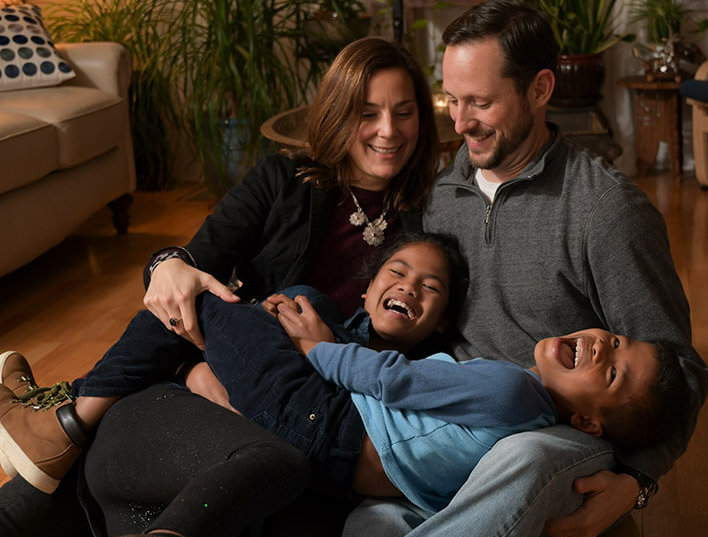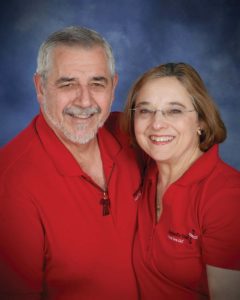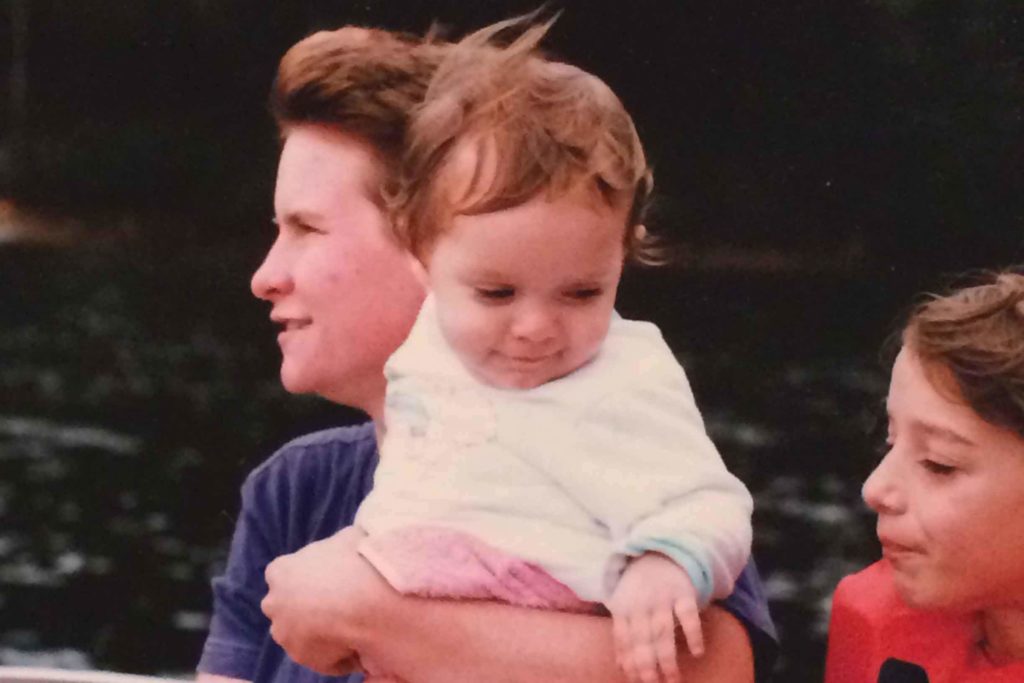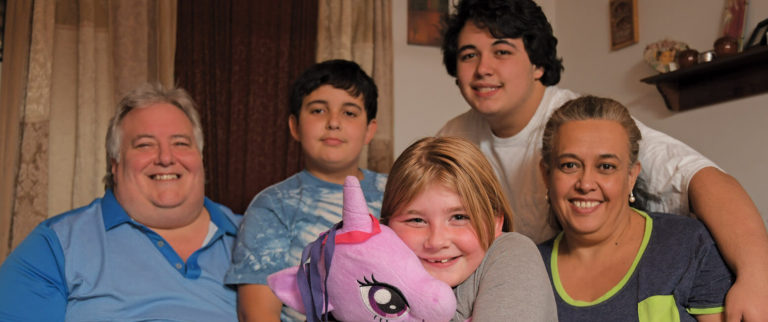Last in a Series
Editor’s Note: Inspired by Matthew 25:40-45, which concludes “ … What you did not do for one of these least ones, you did not do for me,” each month in 2017 the Review will provide an in-depth look at the Catholic Church’s response to those in dire need.
What would you do with a quarter million dollars?
While a vacation home, summering on the Mediterranean or scaling Mount Everest might be on some wish lists, others choose to sacrifice a substantial chunk of their disposable income – let alone their lifestyle – to open their home to a neglected child.
According to the U.S. Department of Agriculture, the estimated cost of feeding, clothing and housing a child born in 2013 over his or her first 18 years – before projected inflation – is almost $250,000, a commitment compounded by private education and college costs.
Nonetheless, according to AdoptionNetwork.com and despite additional costs in application and legal fees, approximately 135,000 children are adopted in the U.S. each year. According to the federal government, another 5,370 children were adopted from foreign countries in fiscal year 2016.
An estimated 428,000 children, meanwhile, are in foster care on any given day in the U.S., according to the Department of Health and Human Services, reflecting a domestic crisis exacerbated by the opioid epidemic.
Just because a child came from a broken home doesn’t mean that he or she will become broken. Over the course of November, National Adoption Month, the Review visited three families which opened their homes to children in need of a stable, loving environment.
This is the 12th and final installment in the Least of These series.
Kids at play

Eric and Mary Hoopert make their home in rural Harford County, a mile south of the Mason-Dixon Line. It is decorated with artwork that reflects their travels, from Costa Rica to Iceland to the Czech Republic to Tanzania – as well as two dozen images of the Blessed Virgin Mary.
Another telling symbol sits at the end of their driveway – a yellow traffic sign that reads “Slow, Kids at Play.” It was placed there after Rachel, 12, and her brother, Samuel, 9, came home with the Hooperts from the Philippines, via Catholic Charities of Baltimore, last May.
The Hooperts contacted the agency at the suggestion of Father A. Henry Kunkel, their pastor at St. Mary in Pylesville. Mary is a nurse practitioner in cardiology, Eric an Army veteran whose service included a tour in Iraq, two in Afghanistan and a Bronze Star.
“You see all those poor kids when you’re deployed,” Eric said. “It sticks with you. … There are plenty of kids out there who need help.”
“They need a family,” said Mary, 42, who added that in-vitro fertilization was not on the table for the couple. “They need to belong, which is what everyone wants.”
In January 2016, Catholic Charities, through its international adoption services, briefed the Hooperts on a brother and sister in an orphanage in Silang, in the province of Cavite. Four months later, as Eric and Mary were on a flight to Manila to meet them, she watched “Lion,” a film about a boy from India adopted by a family in Australia.
“If I weren’t in a public place, I would have been a basket case,” Mary said. “When the boy (in the film) looks in the refrigerator … It was the same way with them.”
Now four, the Hoopert family bonded last summer, when Mary took 12 weeks of vacation and Eric was on break from Towson University, where he’s studying engineering on the GI Bill. The children learned to swim and ride a bike, and honed their English before entering Norrisville Elementary.
Asked their favorite food, Rachel responded with chocolate ice cream, Samuel beef and shrimp. To the dismay of Eric, neither took a liking to Indian food.
“Before, everything you did, you did for yourself,” Mary said. “Now, your feelings don’t matter until their needs are met.”
Far cry
What is 8-year-old Caitie’s favorite thing about her father, Dan?
“When we snuggle,” she said, with one of her favorite Dr. Seuss books.
That image is a far cry from the way she entered the world.
Dan and his wife, Tere (at the request of the family, the Review is withholding the family surname), who came to the U.S. from her native El Salvador in 1995, met when both were working at a big-box store in Silver Spring. “It was only supposed to be one date,” he said, “but it’s lasted 20 years.”
They married in 2000. A year later, their son, Will, was born. Having trouble conceiving again, they applied to Baltimore County Department of Social Services to become adoptive parents. They were approved in 2006 – within days of Tere becoming pregnant with their second son, Danny.
He was 2 when the county called, informing them of a newborn who was a strong candidate to be adopted. She had spent the first nine days of her life detoxing from her birth mother’s abuse of cocaine and other substances. At two weeks, weighing four pounds, Caitie went home with Dan and Tere.
“When people think about adoption, it’s an idyllic scenario,” Dan said. “Unfortunately, that’s not the reality. To be a foster or adoptive parent, sometimes it’s agonizing, but knowing that we might have helped her avoid a bad foundation … ”
Caitie was 22 months old when the legal adoption process was completed. The following weekend, she was baptized by Monsignor Thomas Phillips, their pastor at St. Gabriel in Woodlawn.
“He was instrumental in helping us find the right prayers for the right outcome,” Dan said.
Once diagnosed in the bottom 10 percent developmentally, Caitie now sits in the 90th percentile. According to her father, she and her brother Danny “are as thick as thieves.” She likes singing along at Mass at St. Gabriel, where her father’s guitar fronts a multicultural choir.
Tere’s extended family takes over their home in western Baltimore County at Christmas Eve. Thanksgiving took them to Dan’s family in the Hudson River Valley.
“Dan’s family, they all have this silent laugh, while tears are coming out of their eyes,” she said. “Caitie’s laugh … it’s different. It makes me laugh.”
Her husband said that they might not be done being adoptive or foster parents.
“There are a wealth of children out there who are ready to be adopted,” Dan said. “There are plenty of kids out there who need a home.”
Pay it forward

The marriage preparation for Deacon John Martin and his wife, Angela, major contributors to the fabric of St. Peter the Apostle Parish in Libertytown, included discussions not just about the size of their family, but its nature.
“He told me his story, and asked how I felt about adopting a child,” Angela recalled. “He told me, ‘I want to give back,’ and do what his parents did for him.”
He began life in a dysfunctional home in Washington, D.C., and was 12 in 1965, when both of his biological parents died. One of his grandmothers and the pastor of St. Teresa of Avila Parish helped place him and one of his three siblings with an older couple, Robert and Margaret Marquette.
“I always felt grateful that I was taken in,” Deacon John said. “It was kind of a blur, but when you start doing things with the family, like vacations, it felt more natural.”
He and Angela met as undergrads at the University of Maryland and married in 1975. They were the parents of two boys, still in their 20s themselves and prepared to adopt an equally young child, when Providence sounded a different knock at their door.
“I remember John saying, ‘I wish God would just drop a baby in our lap,’ ” Angela said. “We learned that we’re not in control. When you get out of the driver’s seat and let God take over, wonderful things happen that you can’t even imagine.”
Friends from their parish at the time, St. Timothy in Walkersville, introduced them to a girl who had no place to go for Christmas in 1982.

Not unlike the one Deacon John was born into, Denise LaRock came from a family that was “messed up,” one that was failing to pay her bills at a Virginia boarding school. In the summer of 1983, after six months of intermittent stays with the Martins, she came to live with them permanently.
The local Catholic community helped her enroll at what is now St. John’s Catholic Prep, where she was in the class of 1985. After a year at Mount St. Mary’s, she transferred to Franciscan University of Steubenville, Ohio – which would educate all five of the Martins’ biological children, in order, Bob, Phil, Kelly, Erin and Diana.
While they never legally adopted her, she is considered part of the Martin family, which includes 22 grandchildren.
“We had this desire to give back the opportunity that I was given,” Deacon John said. “We could never imagine the blessings that would come from it.”
He was ordained to the permanent diaconate in 2009 – 18 years after Sister Denise LaRock began her postulancy as a Daughter of Charity of St. Vincent de Paul.
Sister Denise, whose schooling also included the former Visitation Academy in Frederick, has taught at-risk students in Baltimore and the children of migrant workers in South Florida. Now based in San Antonio, she assists asylum-seekers.
“I had a very rough childhood, but I’ve been blessed by so many people along the way,” Sister Denise told the Review. “The Visitation Sisters gave me the seed of my vocation. John and Angela cared for me, and welcomed me into their family.
“The least I could do is to help others, the way I was helped, the way I was blessed.”
Read the other installments of ‘The Least of These’ here.


